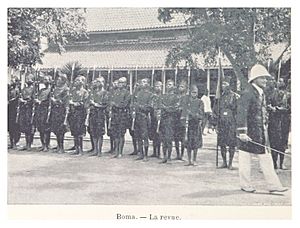Batetela rebellion facts for kids
The Batetela rebellion was a series of three military uprisings in the Congo Free State. It involved members of the Tetela ethnic group. These events happened between 1895 and 1908.
The first uprising began in January 1895. Tetela soldiers of the Force Publique (the colonial army) mutinied in Luluabourg (now Kananga). This sparked a long period of unrest. Two more mutinies followed in other parts of the Congo. The second happened in 1897 during a military trip led by Francis Dhanis. The third and final mutiny was in April 1900. It took place at Fort de Shinkakasa near Boma.
This rebellion was very important in the Congo's history. It was one of the biggest challenges to colonial rule. The last Tetela rebels were finally defeated around 1901.
Contents
What Caused the Batetela Rebellions?
The Force Publique was the army of the Congo Free State. It recruited many soldiers from the Tetela ethnic group. These soldiers came from the Sankuru, Maniema, and Lomami regions. This was especially true during the Congo–Arab War (1892–1894).
The Luluabourg Mutiny of 1895
In January 1895, soldiers in Luluabourg rebelled. They were upset because a leader named Gongo Lutete had been executed. He was accused of being disloyal during the war against the Arabs.
The mutineers killed one of their European officers. Then they escaped. Over the next few years, other Tetela soldiers joined them. By October 1896, there were about 3,000 to 4,000 Batetela rebels.
The Dhanis Expedition Mutiny of 1897
In 1897, a large group of soldiers mutinied. These 1,300 troops were from the Tetela and Kusu ethnic groups. They were part of an expedition led by Baron Francis Dhanis. This force was heading to the Upper Nile region. The soldiers complained about being treated badly.
This was the biggest military force ever put together in colonial Africa at that time. Its goal was to take control of the Fashoda region. This area was part of the collapsing Mahdist State in Sudan (now Kodok, South Sudan). Because of the mutiny, the expedition failed. This meant the Congo Free State avoided a conflict between Britain and France over the Fashoda area.
The mutineers killed 10 Belgian officers. They also took a French priest hostage. Luckily, he was later released unharmed.
The Shinkakasa Mutiny of 1900
The third rebellion started on April 17, 1900. It happened at Fort de Shinkakasa on the Congo River. The rebels took control of the fort. They fired at a ship docked nearby. This threatened the safety of Boma, which was the colonial capital.
Even though they were often defeated, the last Tetela mutineers kept fighting. They held out around Lake Kisale until 1901 or even 1908. After these conflicts, the Belgians changed the Force Publique. They made sure that no single ethnic group made up most of the soldiers in any unit. This was to prevent future large-scale mutinies.


